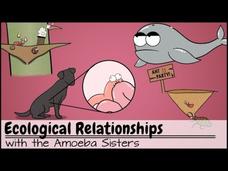Curated Video
What is Symbiosis?
New ReviewSymbiosis is relationship where two different species co-exist and at least one derives benefit from the other. The name for an organism with a symbiotic relationship is a symbiont. Let's look at some examples of symbiotic relationships.
SciShow
Human Parasites
Hank tells us about all of the things that live on us or in us - the good, the bad, and the very, very ugly.
Visual Learning Systems
Introduction to Classifying Plants and Fungi
This video introduces the Classifying Plants and Fungi series. These two very important kingdoms of living things are the focus of this colorful and fascinating program. The major taxonomic categories of these organisms are discussed, as...
Bozeman Science
Populations
Paul Andersen explains how populations interact in an ecosystem. The symbiosis of several populations is based on effects that may be neutral, positive, or negative. Interactions like mutualism, commensalism and parasitism are included....
Mazz Media
Animal Essential Functions
This live-action video program is about the term "animal essential functions". The program is designed to reinforce and support a student's comprehension and retention of the term "animal essential functions" through use of video...
Teacher's Pet
Species Interactions
Learn about predator-prey relationships, interspecific competition, infraspecific competition, competitive exclusion principle, resource partitioning and symbiosis (mutualism, commensalism and parasitism) in this video!
Scholastic
Study Jams: Symbiosis
Three types of symbiosis are explained: parasitism, commensalism, and mutualism. This is done with colorful animation and lively dialogue in a straightforward and easy-to-follow manner. Have your ecology class watch this at home and then...
Teacher's Pet
Species Interactions
Every species competes for food. The video explains interspecific competition, intraspecific competition, and the competitive exclusion principle as a part of predator-prey relationships. It also covers resource partitioning and the...
Bozeman Science
Populations
The largest concentration of free-roaming wildlife in the continental United States is found in Yellowstone National Park. A video describes the three main types of population interactions: mutualism, commensalism, and parasitism. It...
Amoeba Sisters
Ecological Relationships
What are ecological relationships? Well, it can be complicated! Paint a clear picture for pupils with a fun and informative video. It explains and illustrates each relationship thoroughly, from pesky parasites to snuggly symbiotes.
Curated OER
Populations
Every species in the world has some type of relationship with another species, whether it be positive, negative, or neutral for each party. Mr. Andersen defines each type of relationship and provides clear examples under each category....







